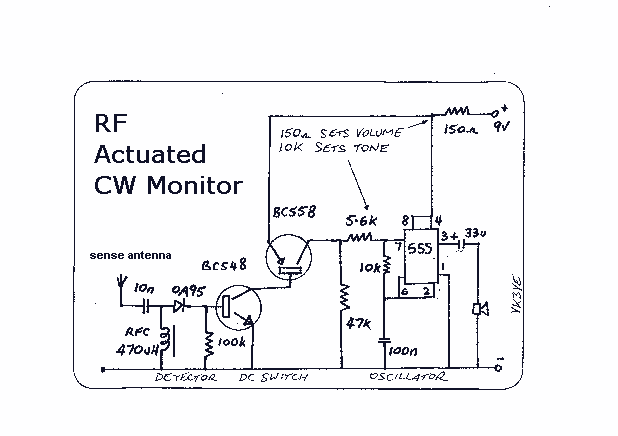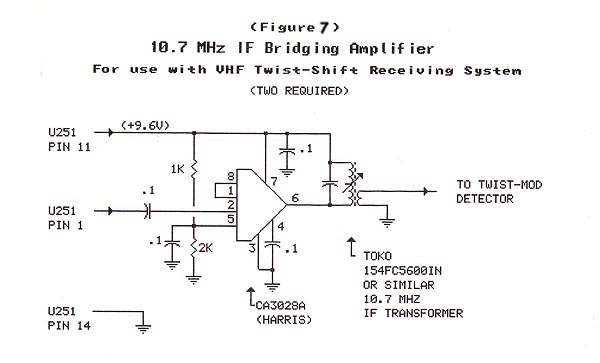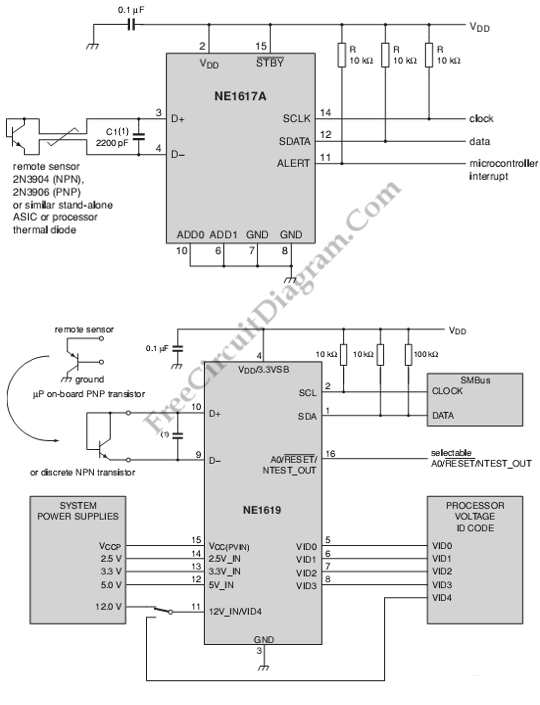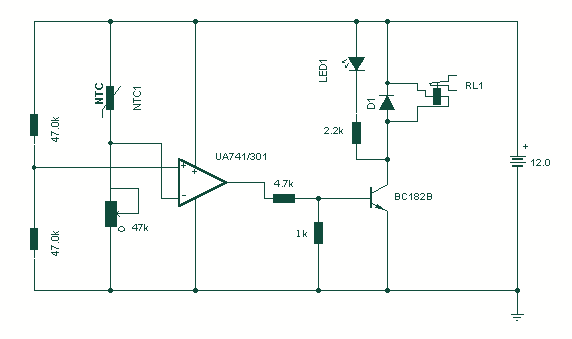
RF Actuated Keying Monitor

Sending Morse on a rig without a sidetone is not impossible, but is not particularly pleasant either. This battery-powered monitor has been designed to provide an audible indication of keying for those whose rigs lack a CW sidetone. Its sensor wire is wrapped around the transceiver's coax; no direct connection is required. Of course, Morse isn't the only use for this nifty circuit; it should also be useful any time you need a simple alarm that detects the presence of RF. RF collected at the sensor wire is rectified by a germanium diode. This produces a DC voltage that triggers a transistor switch.
The described circuit functions as an RF detector and audible alert system, specifically tailored for Morse code transmission applications. The core of this device involves a sensor wire, which is strategically wrapped around the coaxial cable of a transceiver. This configuration allows the circuit to pick up RF signals without the need for a direct electrical connection, thereby simplifying installation and minimizing the risk of interference with the transceiver's operation.
Upon detecting RF signals, the sensor wire generates a small alternating current (AC) voltage. This AC voltage is then fed into a germanium diode, which serves as a rectifier. The germanium diode is selected for its low forward voltage drop, which is advantageous for ensuring that even weak RF signals can be effectively converted into a usable direct current (DC) voltage. The output from the diode is a pulsating DC voltage that corresponds to the intensity of the RF signals detected.
The rectified DC voltage is then utilized to activate a transistor switch. This transistor is configured in such a way that it operates as a low-side switch, meaning it connects the load (in this case, an audible alarm or speaker) to ground when the DC voltage exceeds a certain threshold. The choice of transistor is critical; it must be capable of handling the load current of the alarm device while also being sensitive enough to respond to the low voltage levels produced by the diode.
The audible alert can take the form of a simple piezo buzzer or a small speaker, which will emit sound whenever RF is detected. This provides a clear indication to the operator that the transceiver is in use, even in the absence of a sidetone. Additionally, the circuit can be adapted for other applications, such as an RF presence alarm in various electronic setups, enhancing its versatility.
Overall, this battery-powered monitor circuit is a practical solution for enhancing user experience in Morse code operations and can serve multiple applications where RF detection and alerting are required.Sending Morse on a rig without a sidetone is not impossible, but is not particularly pleasant either. This battery-powered monitor has been designed to provide an audible indication of keying for those whose rigs lack a CW sidetone.
Its sensor wire is wrapped around the transceivers coax no direct connection is required. Of course Morse isnt the only use for this nifty circuit it should also be useful any time you need a simple alarm that detects the presence of RF. RF collected at the sensor wire is rectified by a germanium diode. This produced a DC voltage that triggers a transistor switch. 🔗 External reference
The described circuit functions as an RF detector and audible alert system, specifically tailored for Morse code transmission applications. The core of this device involves a sensor wire, which is strategically wrapped around the coaxial cable of a transceiver. This configuration allows the circuit to pick up RF signals without the need for a direct electrical connection, thereby simplifying installation and minimizing the risk of interference with the transceiver's operation.
Upon detecting RF signals, the sensor wire generates a small alternating current (AC) voltage. This AC voltage is then fed into a germanium diode, which serves as a rectifier. The germanium diode is selected for its low forward voltage drop, which is advantageous for ensuring that even weak RF signals can be effectively converted into a usable direct current (DC) voltage. The output from the diode is a pulsating DC voltage that corresponds to the intensity of the RF signals detected.
The rectified DC voltage is then utilized to activate a transistor switch. This transistor is configured in such a way that it operates as a low-side switch, meaning it connects the load (in this case, an audible alarm or speaker) to ground when the DC voltage exceeds a certain threshold. The choice of transistor is critical; it must be capable of handling the load current of the alarm device while also being sensitive enough to respond to the low voltage levels produced by the diode.
The audible alert can take the form of a simple piezo buzzer or a small speaker, which will emit sound whenever RF is detected. This provides a clear indication to the operator that the transceiver is in use, even in the absence of a sidetone. Additionally, the circuit can be adapted for other applications, such as an RF presence alarm in various electronic setups, enhancing its versatility.
Overall, this battery-powered monitor circuit is a practical solution for enhancing user experience in Morse code operations and can serve multiple applications where RF detection and alerting are required.Sending Morse on a rig without a sidetone is not impossible, but is not particularly pleasant either. This battery-powered monitor has been designed to provide an audible indication of keying for those whose rigs lack a CW sidetone.
Its sensor wire is wrapped around the transceivers coax no direct connection is required. Of course Morse isnt the only use for this nifty circuit it should also be useful any time you need a simple alarm that detects the presence of RF. RF collected at the sensor wire is rectified by a germanium diode. This produced a DC voltage that triggers a transistor switch. 🔗 External reference





